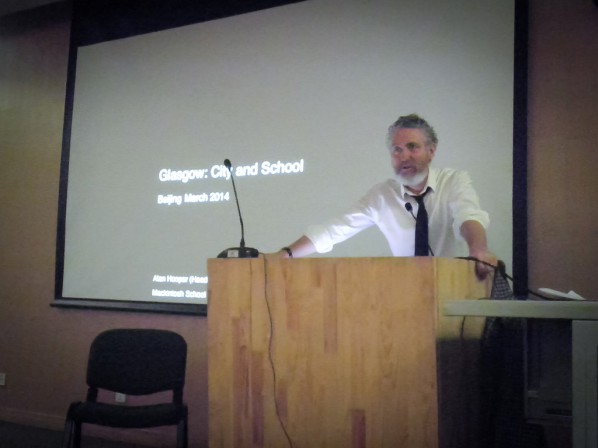
At half past six on the evening on March 12, 2014, Professor Alan Hooper from the Department of Architecture of the Glasgow School of Art gave a lecture entitled “Glasgow – City and School” at the Red Chair Lecture Hall of CAFA. The lecture was divided into two parts, first there was an introduction of the development of Glasgow, secondly an expounding of the relationship between architect Mackintosh and Glasgow School of Art.
Ahead of Glasgow appeared, Scotland which was mainly alluvial plains and mountains formed by melting glaciers. Glasgow began to build a settlement in 1250, and the people lived along the river until in 1450, they spread across the shores of the river. In 1650, the residents started the migration along the alluvial plains, until 1775, the city gradually developed toward the south and the west, where the basic trading pattern emerged. In 1805, on the south bank, the first town emerged. And the second one emerged in the mountains in 1835. By 1850, Glasgow developed towards the west along the river, and established the University of Glasgow, but the west of the city was not developed at that time. Urban development reached a peak in 1910, which was closely associated with the mountains and rivers. The River Clyde is one of the important factors of the development of Glasgow, because it serves as a transport hub, connecting Glasgow with the adjacent waters, opening up the trade exchanges between Glasgow and Asian, African and American continents. It is of an important historical and cultural value, and is conducive to the development of Glasgow’s heavy industry.
The Glasgow School of Art was founded in 1910, and the President at that time appointed the architect Charles Rennie Mackintosh (1868-1928) to design it. Mackintosh was a representative of the Glasgow School, and he discovered the so-called “the old spirit” to design unique buildings, interiors and products of a new style. He was an important figure linking the craft art period and modernism, playing an essential role in the history of design. Glasgow School of Art project was divided into two stages, firstly in between 1897 and 1899, economic hardships caused the work to cease, this continued to 1907. Although it was only an interval of 10 years, it was across a century. So that the two phases are significantly different in architectural style, the first phase was of an ancient architectural style, while the buildings were modern in the second phase. In the process of designing, all the designs were created at the hands of Mackintosh, including the logo of the school, furniture design, etc. The design concept was to encourage people to enter the building, integrating themselves into the design.
Designed by Charles Rennie Mackintosh, Glasgow School of Art is the only art school in the world where buildings of the campus match the disciplines, and a masterpiece of art, while it carries an unusual meaning with history and humanity behind it. It doesn’t only witness the development of the city of Glasgow, but it is also a loyalty guard, a person with a lifelong dedication to guard Glasgow.
Q&A
1 It’s known that Glasgow is a city based on industry, then how does industrial civilization affect the teaching of the Glasgow School of Art?Alan Hooper: Glasgow initially aimed at cultivating students with industrial design skills.
2 How to combine the identities between the world heritage site in architecture and a functioning school?Alan Hooper: As a world cultural heritage site, the building of the school really brings the school a lot of income and honor. However, our students pay more attention to how to freely and reasonably use the buildings. For example, the school recently solved the issue of the use of the library. Many foreign visitors go to the library, but the school students rarely read books in it, so we are looking for specific solutions.
Text and photo by Zhang Gaoshan, translated by Chen Peihua and edited by Sue/CAFA ART INFO




























